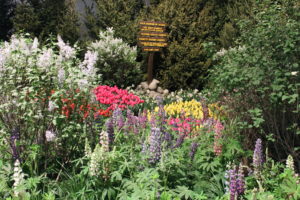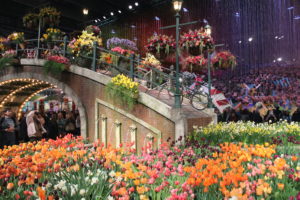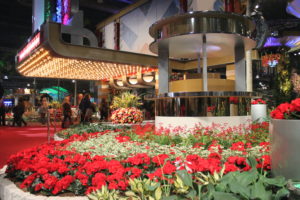How Do They Pull Off the Philadelphia Flower Show???
February 12th, 2019
One of the first things you’ll notice about the Philadelphia Flower Show – besides the really, really welcome 10 acres of plants blooming while it’s still winter – is how elaborate the whole thing is.
We’re not talking about a collection of paver-block rectangles planted with a few daffodils and forsythias.
The Philly show is the world’s biggest, oldest indoor flower show, and I’d wager, also the world’s most impressive.
The 2017 Holland-themed show was named best event in the world by the International Festivals and Events Association, beating out competitors such as the Kentucky Derby Festival and the Tournament of Roses Parade.
I don’t have to tell you that it’s hard enough to grow nice gardens outside when you have nature cooperating at least some of the time.
Inside, the challenge is making gardens happen on concrete floors, in a matter of days, when the snow is still flying outside no less.
It takes incredible knowledge, skill, work, and sometimes good fortune to do the kind of plant displays that the landscapers and garden-builders are famous for at the Philly show.
People come to the Pennsylvania Convention Center from all over the world to see the 40-some display gardens and plant exhibits that get built for just 10-day lifespans the first week of each March.
See my photo gallery of pictures from the 2018 Philadelphia Flower Show
So much of it is well beyond the norm and over the top… 30-foot waterfalls, slices of Dutch bulb fields, rain forests filled with orchids, and replicas of a flower-adorned Eiffel Tower come to mind.
This is, after all, a show, and it’s a chance for the region’s best horticulturists and designers to display what’s amazingly possible with plants.
The Pennsylvania Horticultural Society’s chief of shows and events, Sam Lemheney, did a talk at last year’s show in which he shared some of the details (and fears) that go into pulling off this 190-year-old show.
Picking a theme is one of the biggest decisions. Some years, the show revolves around gardening in countries like England or the Netherlands or Italy. But lately, the trend has been styles or topics.
Besides last year’s water-themed show, the 2016 show celebrated national parks. In 2015, it was a movie theme, and in 2014, the tie-in was art in the garden.
See a list of all show themes since 1960 on the PHS website.
“We know the themes three to four years in advance,” Lemheney says.
He makes the final call on that, but with input from others at PHS and the show’s regular participants.
Lemheney says the biggest considerations are that the theme has to have the potential for a “wow” central feature, it has to have wide appeal, it has to give adequate space for some 40 designers to be creative, and from a practical standpoint, it has to be technically doable.
The show ran into a good example of the latter last year with the “Wonders of Water” theme.
The original idea was to include a suspended rope bridge in the jungle-like main entry, but concerns over people falling led to building a wooden bridge across the floor instead.
Lemheney says the biggest challenge every year – by far – is getting the flowers to cooperate.

It’s not easy to get flowers from different seasons to bloom at a specific time inside and out of season.
“We could put together the show in two months if not for the plants,” he says. “But we need almost a whole year in advance to prepare for them. First you have to chill the plants no later than Oct. 1. Then you give them the right light and warmth in January and February to get them to bloom on time for the show. That varies depending on species. We’ve been doing forcing since the 1800s, so we have a lot of know-how on what to do when.”
Much of the bloom-forcing is done in greenhouses at the PHS-owned Meadowbrook Farm, which is an excellent public garden worth touring, by the way.
Dealing with living things – especially things as fickle as plants – is never easy. So despite PHS’s experience, failures still happen.
Designers last year were hoping to show water-lily platters that grow three feet across for a pond in the central feature. These are the kind that Longwood Gardens grows so impressively every summer.
But the plan to grow them inside in a Philadelphia winter, have them peaking and healthy for early March, and ship them in one piece to the concrete Convention Center show floor didn’t work out. The lily babies went kaput, and designers had to fall back on Plan B, which is always a must in the indoor-show business.
Philly’s flower forcers, in fact, have backup sets of a lot of the plants used in the displays. They’ll chill them and start them a few days or more apart to cover the vagaries in hitting the timing just right.
If something is moving along too fast, you can slow them down a little by shortening the light in the greenhouse and giving them less heat. If something is lagging, you can speed it up a little by increasing light and temperature.
The other issue is that not all of the flowers have the lasting ability to look good for all 10 of the show’s days. You might not realize that many of the flowers in the show are switched out with fresh substitutes midway through so things are looking as good at the end of the show as the beginning.
As for the elaborate gazebos, buildings, and other structures that go into the show, the participants generally build those off-site months in advance. Then they’re disassembled, moved to the Convention Center at the beginning of setup, then reassembled on site.
“It all goes up in 10 days, but it comes down in three,” says Lemheney.
Some of the display plants are bought or given away for use in gardens, some are salvageable for landscaping projects, but a lot are annuals or ones that will never recover from the insult of forcing. Those end up sacrificing themselves for the wonderment of this once-and-done spectacle.
If you’ve never seen the Philadelphia Flower Show, it’s well worth getting there – even if you’re not a gardener. It’s that impressive.
If nothing else, I can think of a lot worse ways to spend a late-winter day than sniffing orchids.
This year’s show theme is “Flower Power,” and it’s inspired by the 1960s and the 50th anniversary of Woodstock.
The entry will feature sculptures inspired by pop artists Andy Warhol and Roy Lichtenstein amid a hanging meadow of more than 18,000 flowers.
This year’s show also will host the FTD World Cup, a sort of international floral-arranging Olympics that pits top designers from two dozen countries against one another.
Lowee’s Group Tours and I will be taking busloads of local gardeners to see the show each of the five weekdays. Details are on my George’s Talks and Trips page.










